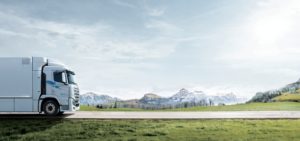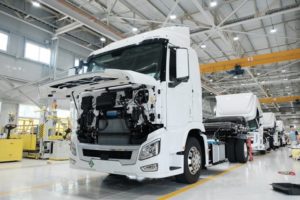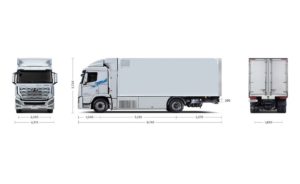Hyundai Motor Company has shipped the first 10 Hyundai Xcient fuel cell trucks to Switzerland, the first of 50 Hyundai Xcient fuel cell trucks that will be shipped to Switzerland this year.
The trucks will join the Swiss customer fleet from September.


“Xcient Fuel Cell is a reality today, not just a project on a future drawing board,” said In-chul Lee, Executive Vice President and Head of Commercial Vehicle Division at Hyundai Motor. “By putting this pioneering vehicle on the road now, Hyundai marks an important milestone in the history of commercial vehicles and the development of a hydrogen society.” Building a comprehensive hydrogen ecosystem, where critical transportation needs are met by vehicles like Xcient Fuel Cell, will lead to a radical shift that removes automobile emissions from the environmental equation.
“Having introduced the world’s first mass-produced fuel cell electric passenger vehicle, the ix35, and the second-generation fuel cell electric vehicle, the Nexo, Hyundai is now leveraging decades of experience, world-leading fuel cell technology and mass production capacity to develop hydrogen in the commercial vehicle sector with Xcient Fuel Cell,” he added.
Xcient Fuel Cell
The Xcient truck is based on a 190 kW hydrogen fuel cell system with two 95 kW fuel cell stacks. Seven large hydrogen tanks provide a combined storage capacity of approximately 32.09 kg of hydrogen. The Xcient Fuel Cell truck has a driving range of approximately 400 km per charge* and was developed with an ideal balance between the specific requirements of potential commercial fleet customers and the charging infrastructure in Switzerland. Refueling time for each truck is approximately 8 to 20 minutes.
Fuel cell technology is particularly well-suited to commercial shipping and logistics due to its long range and short refueling times. The dual fuel cell system provides enough power to propel heavy trucks up and down the region’s mountainous terrain.
Hyundai Motor is developing a long-range tractor unit capable of traveling 1,000 kilometers on a single charge and equipped with an enhanced fuel cell system with high durability and power, targeting global markets including North America and Europe.
Green Hydrogen Ecosystem
 In 2019, Hyundai Motor formed Hyundai Hydrogen Mobility (HHM), a joint venture with Swiss company H2 Energy, which will lease the trucks to commercial truck operators on a pay-per-use basis, meaning there is no upfront investment for commercial fleet customers.
In 2019, Hyundai Motor formed Hyundai Hydrogen Mobility (HHM), a joint venture with Swiss company H2 Energy, which will lease the trucks to commercial truck operators on a pay-per-use basis, meaning there is no upfront investment for commercial fleet customers.
Hyundai chose Switzerland as a starting point for its commercial project for various reasons. One reason is the Swiss LSVA road tax on commercial vehicles, which does not apply to zero-emission trucks. This roughly equates to the transport costs per kilometer of a fuel cell truck compared to a regular diesel truck.
Hyundai’s business plan involves using purely clean hydrogen generated from hydropower. To truly reduce carbon emissions, all trucks would need to run on only green hydrogen. Switzerland is the country with one of the highest shares of hydropower in the world, and can therefore provide enough green energy to produce hydrogen. Once the project starts in Switzerland, Hyundai plans to expand it to other European countries as well.
Hyundai Hydrogen Driving


In December 2018, Hyundai Motor Group announced its long-term roadmap, “Fuel Cell Vision 2030,” and reaffirmed its commitment to accelerating the development of a hydrogen society by leveraging its global leadership in fuel cell technologies. As part of this plan, Hyundai Motor Group aims to secure 700,000 units per year of fuel cell systems for automobiles as well as ships, rail cars, drones and power generators by 2030.
* Driving distance range is about 400 km in a 4X2 truck with a refrigerated configuration while operating a 34 ton truck + trailer combination.
Main Specifications
Item Model Xcient Fuel Cell Vehicle Type Cargo (Chassis Cab) Cab Type Day Cab Drive System LHD / 4X2 Dimensions (mm) Wheelbase 5,130 Overall (Chassis Cab) Length 9,745 Width 2,515
(2,550 with side guard), maximum allowable width 2,600
Height 3,730 Weight (kg) Max. GVW 36,000 Max. Towing Capacity 19,000 Max. GVW 19,000 Rigid Truck Front/Rear 8,000 / 11,500 Curb Weight (Chassis Cab) 9,795 Calculated Performance Driving Range Exact Range To Be Confirmed Max. Speed 85 km/h Powertrain Fuel cell 190 kW (95 kW x 2 units) Battery 661 V / 73.2 kWh – from Akasol Motor / Inverter 350 kW / 3400 Nm – from Siemens Transmission ATM S4500 – from Allison / 6 forward speeds and 1 reverse speed Rear axle ratio 4.875 Hydrogen tank filling pressure 350 bar Capacity 32.09 kg H2 (amount of hydrogen available at 100% SOF) Brake service Disc brakes Brake assist Damper (4 speeds) Suspension type Front / rear Air (2 bags) / Air (4 bags) Tires Front / rear 315/70R22.5 / 315/70R22.5 Safety Forward Collision Avoidance Assist (FCA) Standard Smart Cruise Control (SCC) Standard Electronic Braking System (EBS) +
Vehicle Dynamic Control (VDC)
Standard (ABS included in VDC) Lane Departure Warning (LDW) Standard Airbag Option *#Hyundai Motor Company reserves the right to change specifications and equipment without prior notice.
Source: Hyundai Motor Company





